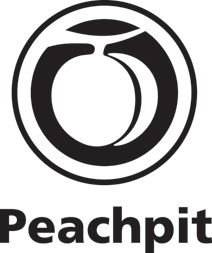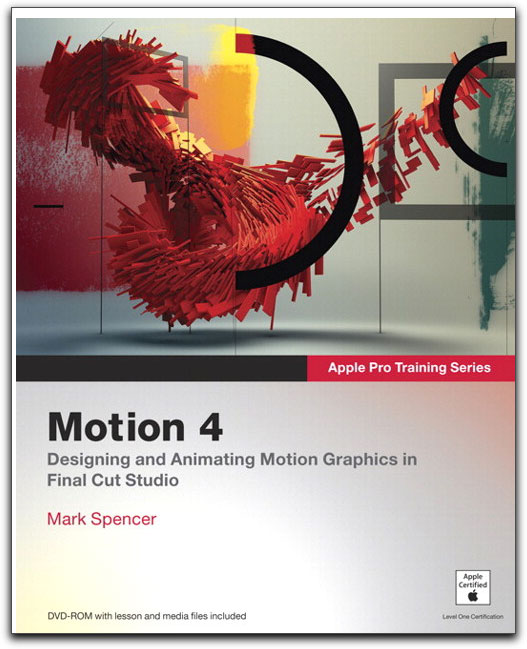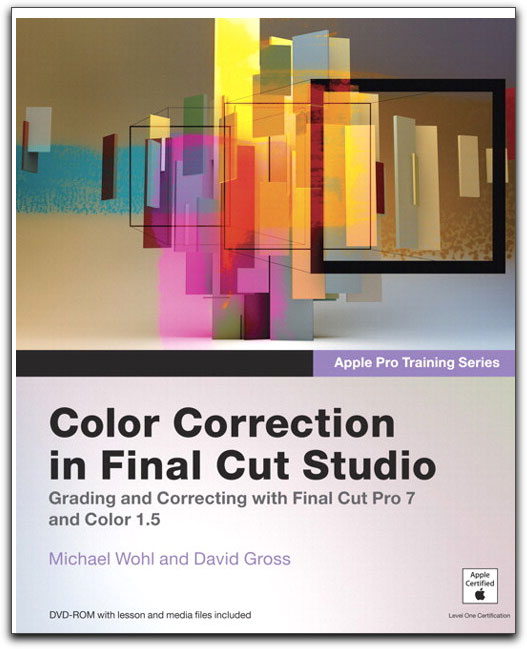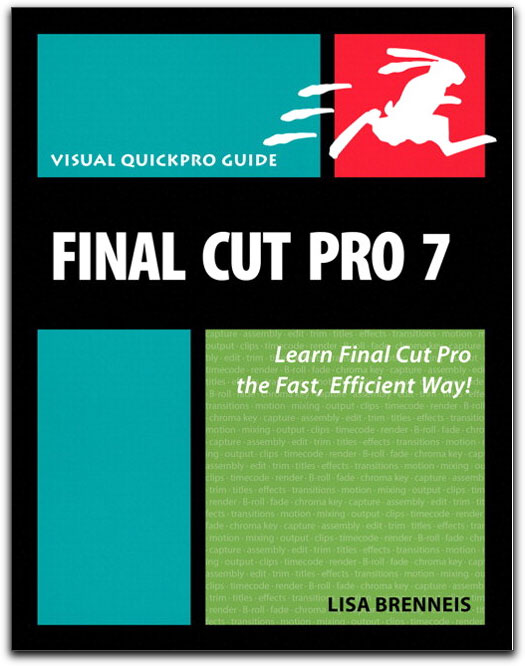
December 14, 2009
www.peachpit.com
Final Cut 7 by Diana Weynand, $49.49
Motion 4 by Mark Spencer $49.49
Color Correction in Final Cut Studio by Michael Wohl and David Gross $39.59
The Visual Quickpro Guide for Final Cut 7 by Lisa Brenneis $31.49
Review by Steve Douglas
There was the day early in the revolution and evolution that was Final Cut Pro when there were no books, DVD tutorials or websites to alleviate the learning curve that came with Final Cut Pro version 1. A friend and I would spend hours on the phone just trying to figure out how to close a gap in the timeline or learn how to properly keyframe a motion graphic. The manual that came with FCP version 1 was a mess of gobbledygook and the lexicon was undecipherable. Ten years later we find ourselves with a massive saturation of tutorial DVDs, and books as well as an abundance of editing based websites. Some stand out, however, and can usually be counted on for the quality of instruction they contain. The Peachpit Press have been leaders in this field and continue to publish new books or versions of old ones as applications are updated.

Diana Weynand continues with her series of Final Cut Pro training series books and, if Apple certification is one of your goals, this is the book to go by. The exam is not an easy one and familiarity with this book is a must. Should you fail the exam, you will not know which questions you missed or why, which is a real problem that Apple's testing service has yet to work out. Never the less, Weynand's Final Cut Pro 7 book is the one you will need to study from. Even if certification is not on your list of aspirations, for the new editor, the Apple Pro Training Series for Final Cut Pro 7 is still an excellent way to learn the basics of this NLE. Due attention is paid to the new features found in FC 7 and the added DVD supplies you with excellent quality footage to practice with. Personally, I prefer to use my own footage when attempting to learn a new technique or feature, but the DVD's footage from a variety of sources such as Sea World's "The Making of Believe" and TNT's "Leverage" series is really quite good and a heck of an improvement from previous versions from this series. Each chapter focuses on separate pieces of the Final Cut Pro pie from Editing in Final Cut and Building a Rough Cut to Capturing and Transferring footage to Mixing Audio and Creating Titles and considerably more. It would be nigh impossible to include 100% of what Final Cut Pro can do and how, but I do find that some items are sorely missing. I could find no mention of Final Cuts Smooth Cam filter and how best to apply it, and there is scant attention paid to the import and usage of the many different codecs our cams are shooting these days. With the advent of so many AVCHD cams on the market, and since this book is primarily addressed to the new or intermediate editor, there is an excellent chance that many of these people are shooting in AVCHD and wouldn't it be helpful for this book to address their needs?
My bottom line is that Weynand's book is a good update of her previous Training Series books. It is not a whole revision and for those already owning her Final Cut 6 book, you might not need to buy this one. However, for those who have not yet purchased a Final Cut Pro training series by Weynand, this book would be a great way to start learning just what your NLE can do.

Motion 4, Designing and Animating Motion Graphics in Final Cut Studio by Mark Spencer is another in the Apple Pro Training Series and one that I believe will be valuable to any editor regardless of how advanced they may or may not be. Having shared previous credits with Damian Allen who started the series, Mr. Spencer has grabbed the reins for the entire ride. Using previous versions of this book as a basic template, Mark Spencer, with the help of the supplied DVD containing the media needed to work through the many projects, does an excellent job leading you through the applications tools and techniques. Detailed attention is paid to the beginning user who is just getting his feet wet with Motion 4 as well as for the intermediate and advanced user seeking a better understanding and insight into Motion 4. Chapters regarding Optical Flow and building a 3D scene were both thorough and informative. Mr. Spencer's writing style is both friendly as well as clear and concise. As one might find in all the Apple Pro Training series, there are many highlighted key points and helpful tips scattered throughout the book. For the beginner, it would be best to copy over the media from the supplied DVD to your hard drive and work at your own pace from the beginning to the end of the book. For those a bit more advanced, skipping to the chapters you need and applying the techniques to your own projects should prove to be most rewarding.
For those seeking Apple certification in Motion 4, this, as are all the books in the Training Series, is the book you will need to study from.

Color Correction in Final Cut Studio by Michael Whol & David Gross is a book I was anxiously awaiting as my own skills in Color 1.5 have much to be desired. While most color correction can be done in Final Cut Pro 7 the art of color grading is a whole different ball game. In most theatrical releases the editor passes off the film to a professional colorist who achieves the directors vision of his/her film. Since the majority of editors must wear all the hats in production from shooter, to lighting, editing and color correction and grading, this new book should be of tremendous help in developing your color management and grading skills. It's not often that a single book will go into detail on two individual applications, in this case, both color correction in Final Cut Pro and Apple's Color which only appeared on the scene in Final Cut Studio 2. While, as part of the Apple Pro Training Series, it also is used as certification reference material, this book is not meant to replace the documentation that comes with the application and is not intended as a fully comprehensive manual. Never the less, it, along with the supplied DVD utilizing footage from TNTs 'Leverage' program does supply you with more than enough projects, tips and help than you will need. While I have not worked my way through the entire book as yet, the structure is completely logical and progressive taking you through the basics of Color Grading in Final Cut Pro before headed on to an easy to understand introduction to the Color application. From there you learn and practice a bit more going through Secondary Color Grading and many of the effects that can be achieved. I always laugh when I watch CSI Miami. No matter how bright the day is, the ground and streets are always wet and everything has a golden tinge to it. Well, there's a complete little section as to just how to get that look. By the time you reach lesson 10 you should have an excellent understanding and background using Color 1.5 and then it is on to chapters utilizing more advanced techniques and finishing methods. I'm not there yet but look forward to getting there. Though a great introduction for the novice, I highly recommend this one especially for the intermediate and advanced user.

Visual Quickpro Guide to Final Cut by Lisa Brenneis has always been a mainstay in anyone's editing library. It was always the one and main book to have by your side as the most complete reference book to use when I needed to check on a function or feature. The new version for Final Cut Pro 7 is basically the same as it has always been, a reference book, not a tutorial with DVD supplied media, nor a project based series of tasks to complete. In the past, when you needed information and guidance quickly, this was the book to go to. Unfortunately, as with the previous version regarding Final Cut Pro 6, too much important information has been left out. Wanting to read the sections regarding some of the new features found in Final Cut Pro 7 I was referred to go to the Apple manual or installation disc and locate a PDF to download. I first noticed this when I looked up 'Changing Clip Speed'. While it even provides the page to look for (page 1143), if I need to review something quick, the last thing I want to do is to be referred to the another site or book.
On the same note, it seems that many new editors frequently have problems learning how to best use the Boris Calligraphy generator. Again, if you should look it up you will only find a paragraph instructing you to open the PDF document found in the Final Cut Studio Installation DVD. This is not something I would want to have to do. I could also not find any discussion of the new Pro Res codecs now available in Final Cut 7 and there is, again, only a reference to a PDF doc in the Apple User Manual for anyone wanting to know more about the new iChat Theater Preview. Want info on the new Alpha Transitions? Don't look in the index because it's not there. So it seems as if the newest features in Final Cut Pro have been eliminated from this latest version of the Quickpro Guide. While there is still a huge reservoir of excellent information found within, should you already have one of Ms. Brenneis's previous versions, I really can't recommend you purchasing what amounts to the same book with a different cover. A reference book should be just that, something you quickly refer to and check on straight and quick, there sould be no need to have to go elsewhere to download PDFs. This greatly diminishes the value of the book and the reasons to purchase it in the first place. I have always loved it when Ms. Brenneis put out a new book, as I knew I could get what I needed without too much of an interruption in my workflow. I'm disappointed in this one.
That said, Peachpit Press continues to supply the editing community with the latest and greatest publications regarding Final Cut Studio and more. While I would rather pay extra for 10 extra pages in a book rather than be referred elsewhere for the information I need, I still believe that if a person wants to learn their craft from the beginning, these books can be the way to go for many.
 Steve Douglas is a certified Apple Pro for Final Cut Pro 7 and underwater videographer. A winner of the 1999 Pacific Coast Underwater Film Competition, 2003 IVIE competition, 2004 Los Angeles Underwater Photographic competition, and the prestigious 2005 International Beneath the Sea Film Competition, where he also won the Stan Waterman Award for Excellence in Underwater Videography and 'Diver of the Year', Steve was a safety diver on the feature film "The Deep Blue Sea", contributed footage to the Seaworld Park's Atlantis production, and productions for National Geographic and the History channels. Steve was a feature writer for Asian Diver Magazine and is one of the founding organizers of the San Diego UnderSea Film Exhibition. He is available for both private and group seminars for Final Cut Pro and leads underwater filming expeditions and African safaris with upcoming excursions to Kenya, Yap, Lembeh Straits, Indonesia, Wakatobi Resort and Bali. Feel free to contact him if you are interested in joining Steve on any of these exciting trips. www.worldfilmsandtravel.com
Steve Douglas is a certified Apple Pro for Final Cut Pro 7 and underwater videographer. A winner of the 1999 Pacific Coast Underwater Film Competition, 2003 IVIE competition, 2004 Los Angeles Underwater Photographic competition, and the prestigious 2005 International Beneath the Sea Film Competition, where he also won the Stan Waterman Award for Excellence in Underwater Videography and 'Diver of the Year', Steve was a safety diver on the feature film "The Deep Blue Sea", contributed footage to the Seaworld Park's Atlantis production, and productions for National Geographic and the History channels. Steve was a feature writer for Asian Diver Magazine and is one of the founding organizers of the San Diego UnderSea Film Exhibition. He is available for both private and group seminars for Final Cut Pro and leads underwater filming expeditions and African safaris with upcoming excursions to Kenya, Yap, Lembeh Straits, Indonesia, Wakatobi Resort and Bali. Feel free to contact him if you are interested in joining Steve on any of these exciting trips. www.worldfilmsandtravel.com